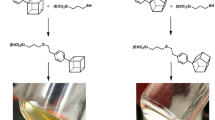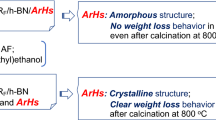Abstract
In this work different synthesis routes were evaluated with the aim of optimizing the incorporation of niobium within a hybrid silica matrix on an atomic scale. The fast kinetics of the hydrolysis/polycondensation of the organic Nb precursor Nb(OEt)5 entails a segregation of the resulting material into Nb2O5 and a silica based network. To overcome this effect we (a) performed a prehydrolysis of 1,2-bis-triethoxy-ethane (BTESE) prior to adding niobium penta-ethoxide, or (b) attempted to reduce the availability of Nb via a complexation of Nb by either acetylacetone or 2-methoxyethanol. The network organization was evaluated from results of Fourier transform infrared as well as 13C, 29Si and 17O MAS NMR spectroscopy. Whereas the prehydrolysis of BTESE and the addition of 2-methoxyethanol induced only moderate mixing of Nb and Si, leading to a network in which islands of Nb2O5 are linked to the hosting silica based matrix via Nb–O–Si bonds, the use of acetylacetonate lead to a mixing of Nb and Si on the atomic scale, forming a mixed Nb–O–Si network without any extended clusters of segregated Nb2O5. The Si–C–C–Si bridge from the silsesquioxane is found to survive the condensation process and is even present in the resulting materials after annealing at 200 °C.





Similar content being viewed by others
References
Castricum HL, Kreiter R, Van Veen HM, Blank DHA, Vente JF, Ten Elshof JE (2008) High-performance hybrid pervaporation membranes with superior hydrothermal and acid stability. J Membr Sci 324(1–2):111–118
Kong C, Koushima A, Kamada T, Shintani T, Kanezashi M, Yoshioka T, Tsuru T (2011) Enhanced performance of inorganic-polyamide nanocomposite membranes prepared by metal-alkoxide-assisted interfacial polymerization. J Membr Sci 366(1–2):382–388
Castricum HL, Sah A, Kreiter R, Blank DHA, Vente JF, Ten Elshof JE (2008) Hybrid ceramic nanosieves: stabilizing nanopores with organic links. Chem Commun 9:1103–1105
Kreiter R, Rietkerk MDA, Castricum HL, Van Veen HM, Ten Elshof JE, Vente JF (2009) Stable hybrid silica nanosieve membranes for the dehydration of lower alcohols. ChemSusChem 2(2):158–160
Kreiter R, Rietkerk MDA, Castricum HL, Van Veen HM, Ten Elshof JE, Vente JF (2011) Evaluation of hybrid silica sols for stable microporous membranes using high-throughput screening. J Sol–Gel Sci Technol 57(3):245–252
Kanezashi M, Yada K, Yoshioka T, Tsuru T (2010) Organic–inorganic hybrid silica membranes with controlled silica network size: preparation and gas permeation characteristics. J Membr Sci 348(1–2):310–318
Chang K-S, Yoshioka T, Kanezashi M, Tsuru T, Tung K-L (2010) A molecular dynamics simulation of a homogeneous organic–inorganic hybrid silica membrane. Chem Commun 46(48):9140–9142
Igi R, Yoshioka T, Ikuhara YH, Iwamoto Y, Tsuru T (2008) Characterization of co-doped silica for improved hydrothermal stability and application to hydrogen separation membranes at high temperatures. J Am Ceram Soc 91(9):2975–2981
Kanezashi M, Asaeda M (2006) Hydrogen permeation characteristics and stability of Ni-doped silica membranes in steam at high temperature. J Membr Sci 271(1–2):86–93
Qi H, Chen H, Li L, Zhu G, Xu N (2012) Effect of Nb content on hydrothermal stability of a novel ethylene-bridged silsesquioxane molecular sieving membrane for H2/CO2 separation. J Membr Sci 421–422:190–200
Qi H, Han J, Xu N, Bouwmeester HJM (2010) Hybrid organic–inorganic microporous membranes with high hydrothermal stability for the separation of carbon dioxide. ChemSusChem 3(12):1375–1378
Boffa V, ten Elshof JE, Petukhov AV, Blank DH (2008) Microporous niobia–silica membrane with very low CO2 permeability. ChemSusChem 1(5):437–443
Boffa V, ten Elshof JE, Garcia R, Blank DHA (2009) Microporous niobia–silica membranes: influence of sol composition and structure on gas transport properties. Microporous Mesoporous Mater 118(1–3):202–209
Yoshida K, Hirano Y, Fujii H, Tsuru T, Asaeda M (2001) Hydrothermal stability and performance of silica–zirconia membranes for hydrogen separation in hydrothermal conditions. J Chem Eng Jpn 34(4):523–530
Ziolek M, Nowak I (1997) Synthesis and characterization of niobium-containing MCM-41. Zeolites 18(5–6):356–360
Nowak I (2012) Frontiers in mesoporous molecular sieves containing niobium: from model materials to catalysts. Catal Today 192(1):80–88
Sedlar M, Sayer M (1995) Reactivity of titanium isopropoxide, zirconium propoxide and niobium ethoxide in the system of 2-methoxyethanol, 2,4-pentanedione and water. J Sol–Gel Sci Technol 5(1):27–40
Spijksma GI, Bouwmeester HJM, Blank DHA, Kessler VG (2004) Stabilization and destabilization of zirconium propoxide precursors by acetylacetone. Chem Commun 10(16):1874–1875
Bradley DC, Holloway CE (1968) Nuclear magnetic resonance studies on niobium and tantalum penta-alkoxides. J Chem Soc A 1968:219–223
Ibers JA (1963) Crystal and molecular structure of titanium (IV) ethoxide. Nature 197(4868):686–687
Blanchard J, In M, Schaudel B, Sanchez C (1998) Hydrolysis and condensation reactions of transition metal alkoxides: calorimetric study and evaluation of the extent of reaction. Eur J Inorg Chem 8:1115–1127
Leaustic A, Babonneau F, Livage J (1989) Structural investigation of the hydrolysis-condensation process of titanium alkoxides Ti(OR)4 (OR = OPr-iso, OEt) modified by acetylacetone. 1. Study of the alkoxide modification. Chem Mater 1(2):240–247
Pickup DM, Mountjoy G, Wallidge GW, Anderson R, Cole JM, Newport RJ, Smith ME (1999) A structural study of (TiO2)x (SiO2)1–x (x = 0.18, 0.30 and 0.41) xerogels prepared using acetylacetone. J Mater Chem 9(6):1299–1305
Gervais C, Babonneau F, Smith ME (2001) Detection, quantification, and magnetic field dependence of solid-state 17O NMR of X − O−Y (X, Y = Si, Ti) linkages: implications for characterizing amorphous titania–silica-based materials. J Phys Chem B 105(10):1971–1977
Delattre L, Babonneau F (1997) 17O Solution NMR characterization of the preparation of sol − gel derived SiO2/TiO2 and SiO2/ZrO2 glasses. Chem Mater 9(11):2385–2394
Nowak I, Ziolek M (1999) Niobium compounds: preparation, characterization, and application in heterogeneous catalysis. Chem Rev 99(12):3603–3624
Bonhomme C, Coelho C, Baccile N, Gervais C, Azaïs T, Babonneau F (2007) Advanced solid state NMR techniques for the characterization of Sol–Gel-derived materials. Acc Chem Res 40(9):738–746
Drake KO, Carta D, Skipper LJ, Sowrey FE, Newport RJ, Smith ME (2005) A multinuclear solid state NMR study of the sol–gel formation of amorphous Nb2O5–SiO2 materials. Solid State Nucl Magn Reson 27(1–2):28–36
Julián B, Gervais C, Rager M-N, Maquet J, Cordoncillo E, Escribano P, Babonneau F, Sanchez C (2004) Solid-state 17O NMR characterization of PDMS − MxOy (M = Ge(IV), Ti(IV), Zr(IV), Nb(V), and Ta(V)) organic − inorganic nanocomposites. Chem Mater 16(3):521–529
Holland MA, Pickup DM, Mountjoy G, Tsang ESC, Wallidge GW, Newport RJ, Smith ME (2000) Synthesis, characterisation and performance of (TiO2)0.18 (SiO2)0.82 xerogel catalysts. J Mater Chem 10(11):2495–2501
Babonneau F, Maquet J (2000) Nuclear magnetic resonance techniques for the structural characterization of siloxane–oxide hybrid materials. Polyhedron 19(3):315–322
Dubinin M (1974) On physical feasibility of Brunauer’s micropore analysis method. J Colloid Interface Sci 46(3):351–356
Kaganer M (1959) A new method for the determination of the specific adsorption surface of adsorbents and other finely dispersed substances. Zh Fiz Khim 33:2202–2210
Cedeño L, Hernandez D, Klimova T, Ramirez J (2003) Synthesis of Nb-containing mesoporous silica molecular sieves: analysis of its potential use in HDS catalysts. Appl Catal A Gen 241(1–2):39–50
Julián B, Gervais C, Cordoncillo E, Escribano P, Babonneau F, Sanchez C (2003) Synthesis and characterization of transparent PDMS-metal-oxo based organic − inorganic nanocomposites. Chem Mater 15(15):3026–3034
Nakamoto K (1986) Infra red and Raman spectra of Inorganic and coordination compounds, 4th edn. Wiley, New York
Jiang H, Zheng Z, Wang X (2008) Kinetic study of methyltriethoxysilane (MTES) hydrolysis by FTIR spectroscopy under different temperatures and solvents. Vib Spectrosc 46(1):1–7
Cai Y, Yang S, Jin S, Yang H, Hou G, Xia J (2011) Electrochemical synthesis, characterization and thermal properties of niobium ethoxide. J Cent South Univ Technol 18(1):73–77
Castricum HL, Sah A, Kreiter R, Blank DHA, Vente JF, Ten Elshof JE (2008) Hydrothermally stable molecular separation membranes from organically linked silica. J Mater Chem 18(18):2150–2158
de Vos RM, Verweij H (1998) Improved performance of silica membranes for gas separation. J Membr Sci 143(1–2):37–51
Qureshi HF, Nijmeijer A, Winnubst L (2013) Influence of sol–gel process parameters on the micro-structure and performance of hybrid silica membranes. J Membr Sci 446:19–25
Author information
Authors and Affiliations
Corresponding author
Rights and permissions
About this article
Cite this article
Besselink, R., Venkatachalam, S., van Wüllen, L. et al. Incorporation of niobium into bridged silsesquioxane based silica networks. J Sol-Gel Sci Technol 70, 473–481 (2014). https://doi.org/10.1007/s10971-014-3308-6
Received:
Accepted:
Published:
Issue Date:
DOI: https://doi.org/10.1007/s10971-014-3308-6




